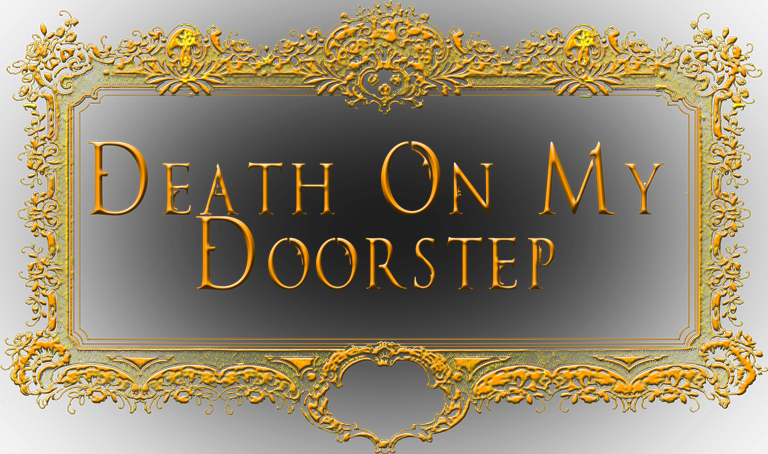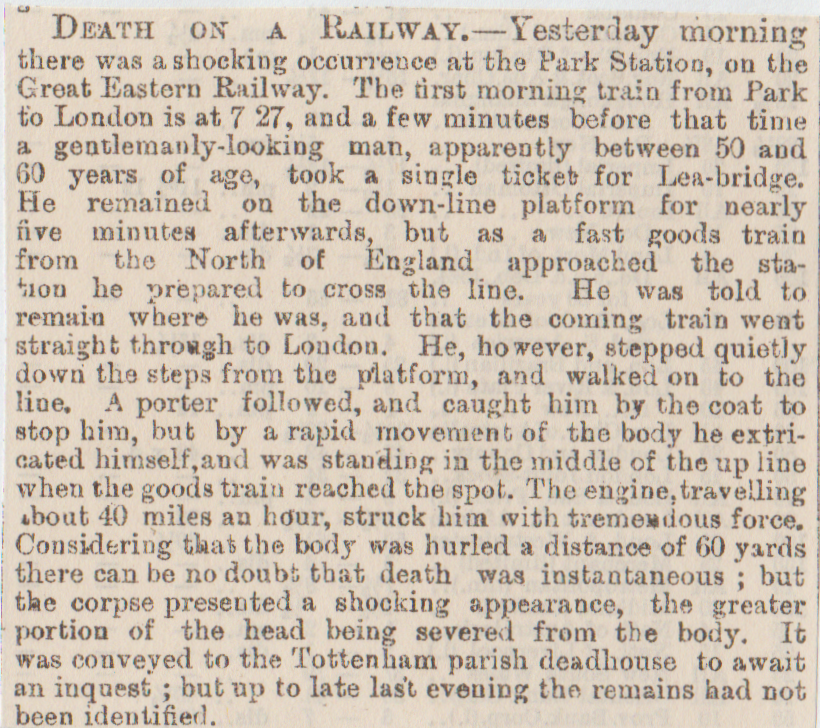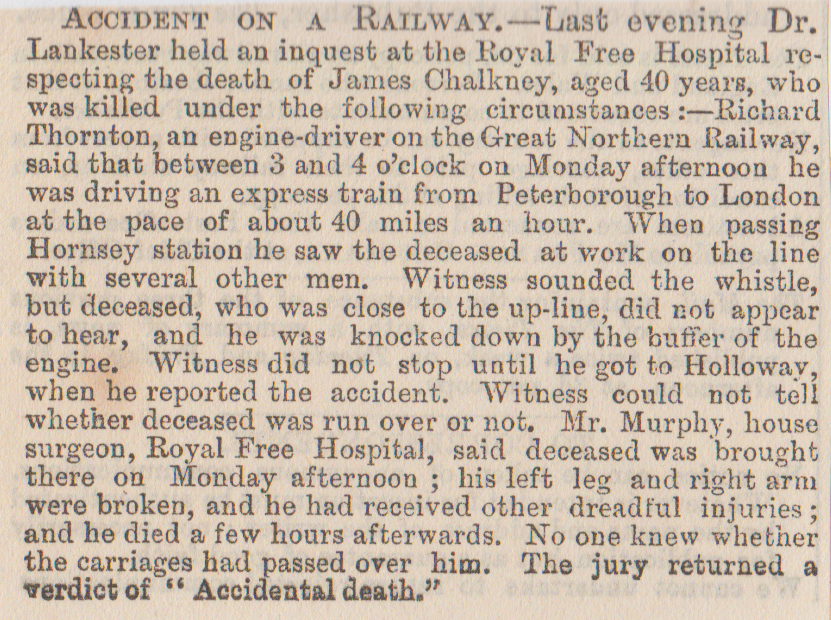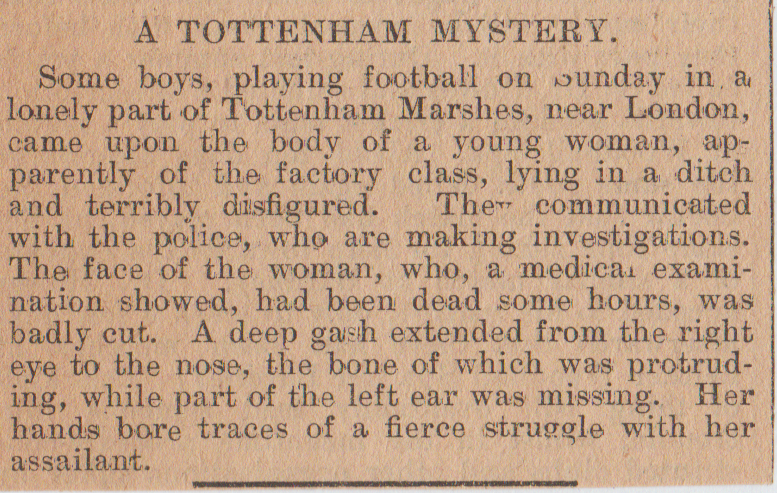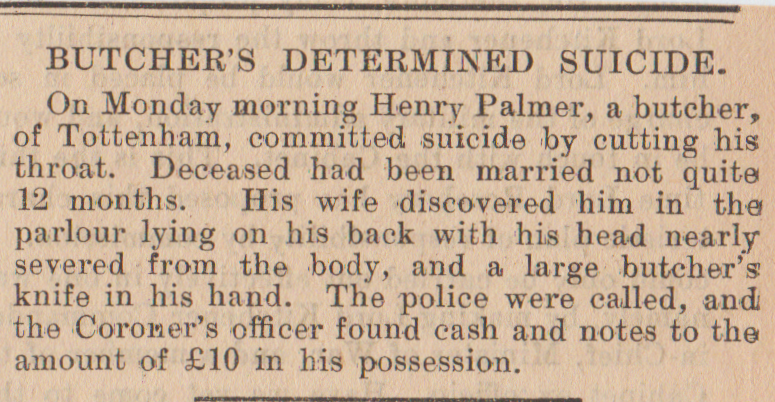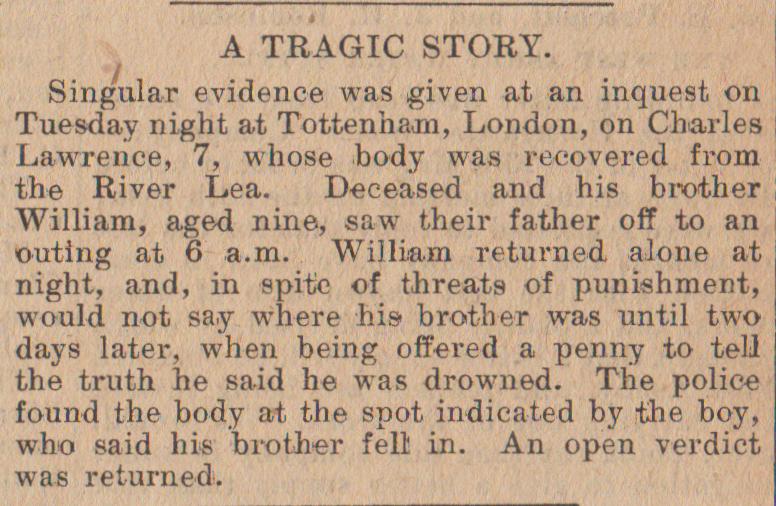1/ Crouch Hill (Mother/Child Deaths) July 1880
A house in Stroud Green Road, Crouch Hill, was being looked after by a servant girl while the family were away. She was not seen for some time and police were called to the address where they found the young girl and the body of a new-born child. Both had died from lack of medical attention, but she had made the effort to keep the child warm by wrapping it in clothing
2/ Wood Green Suicide, October 1877 (Weird Letter)
Here’s a suicide note that Sherlock Holmes would have struggled to work out. It was 28- year -old Karl Hildenbrand, found in a field by a gentleman’s dog on Saturday evening. He was ten yards from the path and had a gold watch and nearly a £1 in money and some papers left on his person. There were two gunshot wounds, one in the ribs and then the deadly one in the forehead. The police surgeon reckoned that he had run some distance after the first shot before putting the gun to his head and pulling the trigger. An address card had Karl Hildenbrand written on it, and also “Take care, there are some more shots in it”. Another scrap of paper was also on the body and this little outburst of gibberish read: “Hampstead Heath (erased) Unique scalping; Red Indian jungle; unmitigated international atrocities; Almighty moonshine; Ichthyosaurus Hyperborean; Atheistic outlaw; Departure to the Styx of two honorary members of the Skeleton Club”. Go figure that one out!
3/ Alexandra Palace Acrobat Death, May 1899
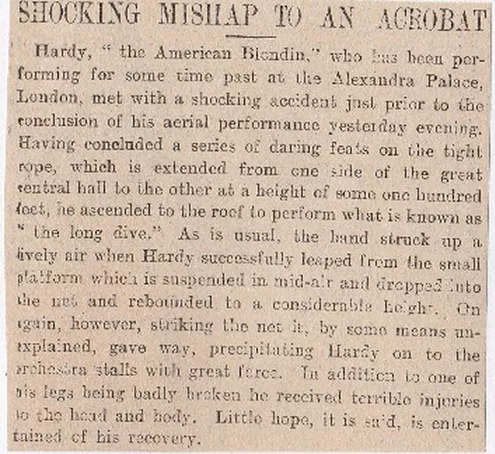
Did Hardy survive or did he die from his injuries?
4/ St Ann’s Road, Tottenham, (Childs Head Found) January 1890
The charred head of a child has been discovered in the garden of a house at St Ann’s Road in Tottenham. It was taken to the local mortuary to await an inquest. (Who was it?)
5/ Alexandra Palace, May 1887 (Child Remains)
Whilst a police officer was on his beat around the premises at Alexandra Palace, he found a fish-basket which when opened contained the dead bodies of two baby girls. They were wrapped in sack-cloth, and there has been no sign of an identification. The remains were taken to Tottenham to await an inquest there.
6/ Tottenham Suicide, September 1847
There was much chatter about the streets of Tottenham regarding the discovery of a foreign-looking gentleman who had committed suicide. Workmen were near the banks of the River Lea when they saw him come running down towards it. They realised his intentions and went after him, but when he got the water’s edge he pulled out two pistols and pointed one at his head and fired. He fell into the Lea and his lifeless corpse was dragged out. He was quite dead and had no identification on him.
7/ Tottenham, July 1895 (Death by Tickle?)

8/ Quernmore Road, Stroud Green, (Chemistry Set Suicide) February 1918
The 14-year-old schoolboy, Arthur George Easterbrook, who resided with his parents at Quernmore Road, Stroud Green, had a huge interest in chemistry. Unfortunately, his parents never bought him any chemistry equipment so he nicked some bit and bobs from Hornsey Council School. The teachers had noticed stuff going walkabout and two of the masters went to Easterbrook’s home to see what apparatus he had there. A short while later the boy went to his room, wrote a letter saying he hoped that the verdict would not be “Temporarily Insane”, and put his chemical knowledge to some use when he next took some cyanide of potassium and killed himself.
9/ Ridley, Whitly and Co, West Green, Tottenham, February 1895
A terrible accident occurred on Thursday at Messrs.Ridley, Whitly and Co’s oilcloth factory at West Green, Tottenham. A young fellow engaged in the machine room, named W.F.Goodchild, aged 18 years, was caught by the belting and was whirled up into the shafting, being instantly killed.
10/ Crouch End Station Suicide, December 1896
John Dexter from Highgate, a well-known evangelist who was a missionary to the men of the Great Northern & North London Railways, stood calmly in front of the 3-52 from High Barnet to Broad street at Crouch End Station. There were numerous passengers waiting at the station and they witnessed Dexter methodically jump on the tracks and face the oncoming engine. He waved an umbrella (Why is not certain?), and as the driver slammed on the brakes the whole train passed over him. Amazingly, he was pulled from under the train alive and rushed off to the hospital but he died a few hours after admittance.
11/ Philip Lane Murder, Tottenham, November 1910
This is a tragedy that could have been named after this website but that stemmed from the jealousy of the boyfriend, which is another common cause for murder in Victorian Britain. Harry Bright from Steele Road, Tottenham, went to see his girlfriend Bessie Lister, at her house at No 46, Durham Road, Philip Lane. They were chatting away in the back passage for quite a few minutes when Bessie came scampering into the kitchen holding her throat. Her step-mother caught the poor girl and a doctor was called for. He arrived too late and pronounced her dead, due to the jugular vein and carotid artery being slashed. The obvious murderer, Harry Bright, didn’t try to escape or flee but he walked into Tottenham Police Station and gave himself up. The murder weapon, a cut-throat razor, was found on him.
12/ New River near Umfreville Road, Haringey, (Drowning) March 1899

13/ No.6, Spencer Road, Tottenham, May 1884 (Child Murder)
A tragic case of child murder discovered purely by accident occurred at a Victorian equivalent of a council estate. The Industrial Dwelling Association has an estate in Tottenham, and are a group of houses for working-class families at an affordable rent. The company boss employed a cleaner named Miller to polish up the houses ready for when a new tenant was due in. Miller got told to go and clean No 5 Spencer Road, but she went into No 6 by mistake. She saw blood stains on the floor and which formed a trail to the cupboard. The dead body of a child covered in blood was the cause of the blood spatters and police surgeons reckon that due to the decomposition. It was estimated that it had lain there for at least three weeks.
14/ Holmdale Villa, Palace Road, Hornsey, August 1885
This is the suicide of a lady named Annie Wilson aged thirty-three, and living at Holmdale Villa, Palace Road, Hornsey, and the amazing nature of it. Recently she had been showing signs of hysterical mania, and due to these outbursts, she had to have a woman by her side in case she attempted anything serious. Dr Chitty advised that she be admitted to St Luke’s Asylum, and on the day she was due to be taken there she asked Dr Chitty if he could come with her to the institution. She also gave him some coffee granules and said it had poison in it, and could he analyse them for her. Chitty left but was back within the hour as she had taken the stopper from a bottle of shampoo and rammed it down her throat causing her to choke violently, then die. Many efforts were made to remove it but it was so tightly crammed in there it was not possible to get it out. A letter from Wilson to Dr Chitty read: “I beg you in God’s name to give me something to poison me. Think what an object of horror I am. I shall never sleep again. God forgive me. To Dr Chitty.”. The coroner mentioned that if insane people wanted to kill themselves they would somehow find a way. He told of a case of a clergyman who had suicidal tendencies and had four attendants watching him day and night, but he got tiny pieces of rope from the books he was brought, and over a nine-month period crafted a home-made rope from them, then hung himself.
15/ Moselle Avenue, Noel Park, Wood Green, November 1906 (Double Murder)
A lodger at the house at 149, Moselle Avenue, Noel Park, Wood Green, by the name of Arthur Chopping, a baker by trade, murdered in cold blood the two children that also lived there. The mother, Mrs Yorke, put 4-year-old Francis, and two-year-old Beatrice to bed at 7-30 p.m leaving Chopping alone with them. She came back an hour later and found the place was pitch black, and when the light was put on there were bloodstains everywhere. On running upstairs she found Frank lying on the bed with his throat slit and a razor also on the bed, then moving to another room she found her daughter had also had her throat cut. Chopping had walked to the police station and started a violent scrap with a policeman while screaming “I want blood”. He collapsed with exhaustion and was put in a cell. Chopping was charged with the murder of the two children.
16/ Noel Park, Wood Green, December 1885
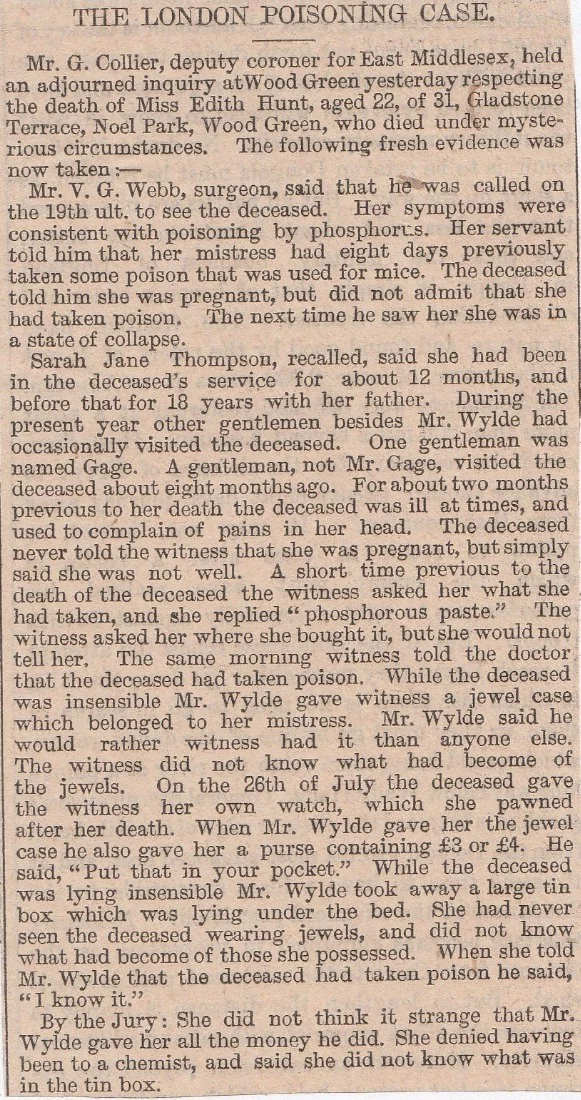
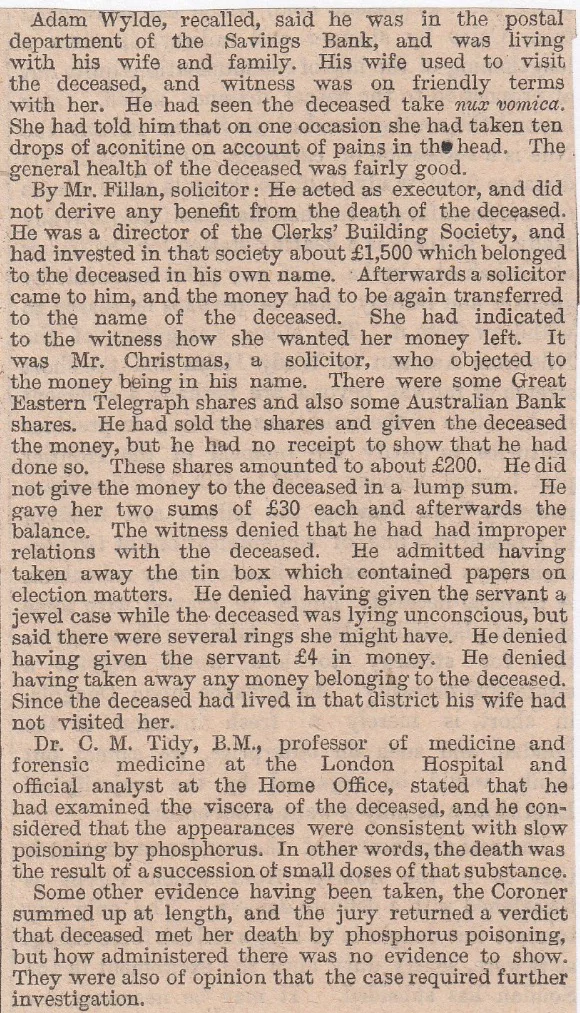
17/ Alexandra Palace Fire, August 1873 (Bodies Found)
(The Ally Pally opened on May 24th,1873. Sixteen days later it was burned to a cinder, killing three members of staff. It was reopened in 1875.) This was the appalling discovery of the bodies of two sisters, Mrs Everett, of 13 Grove Road, and Mrs Constable of Seven Sisters Road in Holloway found amongst the rubble and ashes of Alexandra Palace. They left home on the 24th June to visit the horse show at Alexandra Park and hadn’t been seen since. Richard Hughes was working on the tidying up operation of the building when he came upon the two decomposed, partially buried women. The only thing that could identify them was remnants of their dresses and Mr Everett confirmed that they were the clothes worn by both women. Police ruled out foul play by the position they were found in which was lying face down with masonry on top of them, and arms interlinked, showing that they had been suddenly been overcome by some sort of disaster. Mrs Everett’s skeletal right hand was clinging to both ladies parasol’s.
Alexandra Palace Fire, October 1873
The body of the night watchman at the Alexandra Palace, Richard Norman, has been found in the rubble of that building. He was killed by suffocation and severe burns and was found near the place he was last seen.
18/ Hornsey Wood Bridge Suicide, September 1863
Henry Alfred Powell, aged 23, killed himself under some circumstances at Hornsey Wood Bridge on the New River. He had lived with his father until recently when his sister spotted an ad in the Clerkenwell News from a young girl saying “Henry meet me”. When asked if he was the Henry mentioned he flew into a rage and left the house and vanished for several weeks. When he finally came back his clothes were in tatters and he was emaciated. He told them he had been all over the country. He didn’t stay long, and this was the last time they saw him alive. A chap named Wagon, saw Powell lying on a table in the Manor House Tavern (also where the inquest was held), then he got up and walked down Green Lanes towards the New River. Very early one morning a policeman found his body floating on the New River while he walking over the Hornsey Wood Bridge. He had gold jewellery on him and a bit of cash, so he wasn’t robbed or beaten up by anyone else, so it must have been suicide.
19/ Tottenham, (Remains of Baby) December 1906

20/ Seven Sisters Road/New River, April 1885
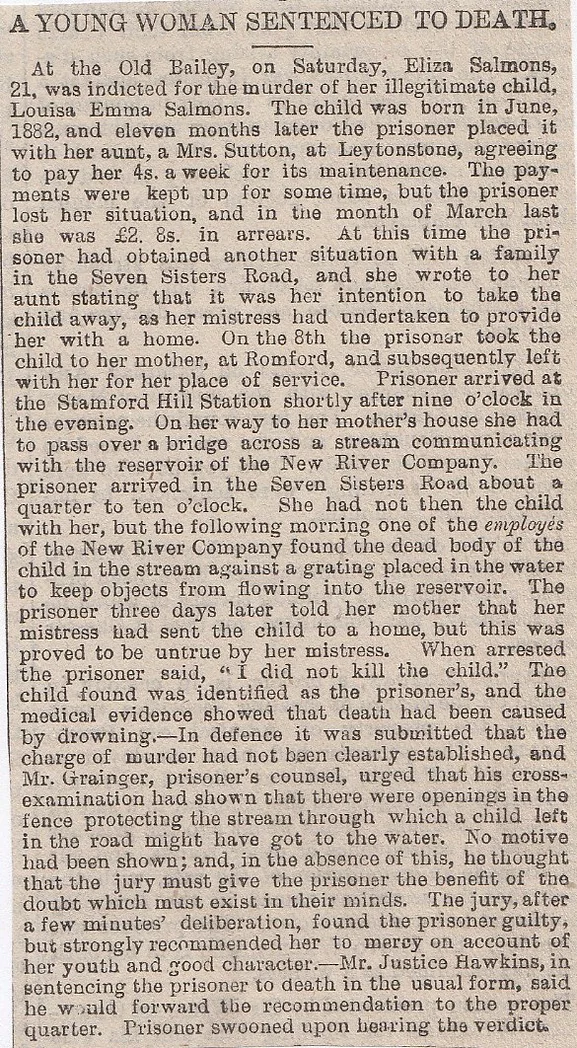
21/ Northumberland Park Railway Death, August 1870 (Northumberland Park Station used to called Park Station)
22/ Hornsey Station Fatality, September 1870
23/ Body Found on Tottenham Marshes, February 1902 (plus George Woolf Execution at Newgate)
May 10th, 1902. Execution at Newgate of George Woolf.
24/ Tottenham Butcher’s Suicide, September 1903.
25/ Boy’s Body Found in the River Lea, July 1903.
26/ Double Suicide on Lordship Lane, Tottenham. November 1904. (Married Man and Teenage Girl Take Poison)
27/ Double Child Murder at Wood Green. November 19th, 1906
December 1906.
At the Central Criminal on Thursday, Arthur Chopping, indicted for the murder of Francis and Clara Yorke, aged four and two respectively, the daughters of his landlady at Wood Green, was found guilty, but insane, and he was ordered to be detained during the King’s pleasure. The day before the tragedy, Chopping had been told he could not stay in the house any longer. The children’s heads were severed with a razor.
28/ Two Men Suffocate to Death, Tottenham. November 1880
29/ Fatal Railway Accident, near Hornsey Station. October 1880
30/ Finsbury Park Murder. November 1880 (William Herbert shot Jane Messenger)
Tuesday 30th November 1880.
Monday, December 13th, has been fixed for the execution of within the walls of Newgate Gaol, of William Herbert, who was convicted of the murder at Finsbury Park. A communication by the Sheriffs to this effect was received without emotion or apparent concern.
